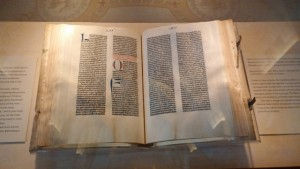About the Gutenberg?

Library of Congress
It was a mass-produced Bible utilizing 'movable metal type’ in *Europe in the 15th Century (January 1, 1401 thru December 31, 1499).The first printed edition of the Bible was in the 1440s. The Gutenberg Bible is also known as the Forty-Two Line Bible because the pages are printed with two columns of 42 lines each.
A Gutenberg Bible contains 1,286 pages. 300 pieces of unique types were used in the printing and each page contains approximately 2,500 pieces of type. It took between three to five years to complete the entire print run of 180 Bibles and each Bible weighs an average of 14 lbs. The printing process was done entirely by hand.
** There are only four known complete Gutenberg Bibles printed on vellum in the world.
9) Of the original 180 Bibles, 49 are known to exist today. 21 of those are still complete.
Johann Gutenberg published them, between 1397 and 1468, 175 bibles were printed utilizing the world’s first movable true type printing press, today less than fifty survive, and many of these are incomplete. Eleven copies have since made their way to the United States.
Of the original 180 printed copies of the Gutenberg Bible, 49 still exist in libraries, universities, and museum collections. Over half are complete, and some only consist of a single volume or even a few scattered pages.
As to value, a Gutenberg Bible originally sold in 1978 for $2.2 million dollars and now recent estimates suggest a complete Gutenberg Bible could bring up to $35 million at auction.
Germany has the most Gutenberg Bibles with 14, while the United States has 10, three of which are owned by the Morgan Library and Museum in Manhattan
One can see one of the few remaining in the world at:
The Widener Library at Harvard University, Cambridge, MA.
Huntington Museum Library, San Marino CA.
Lilly Library, Indiana University, Bloomington, IN
The Library of Congress, in Washington DC. (**Printed on Vallum)
The Morgan Library & Museum (3 copies), New York.
New York Public Library, New York.
Scheide Library, Princeton University, Princeton, NJ
Beinecke Library, Yale University, New Haven, CT.
*Chinese artisans were pressing ink onto paper as early as the second century A.D., and by the 800s, they had produced full-length books using wooden block printing. The movable type also first surfaced in the Far East. Sometime around the mid-11th century.
.png)



















Comentarios